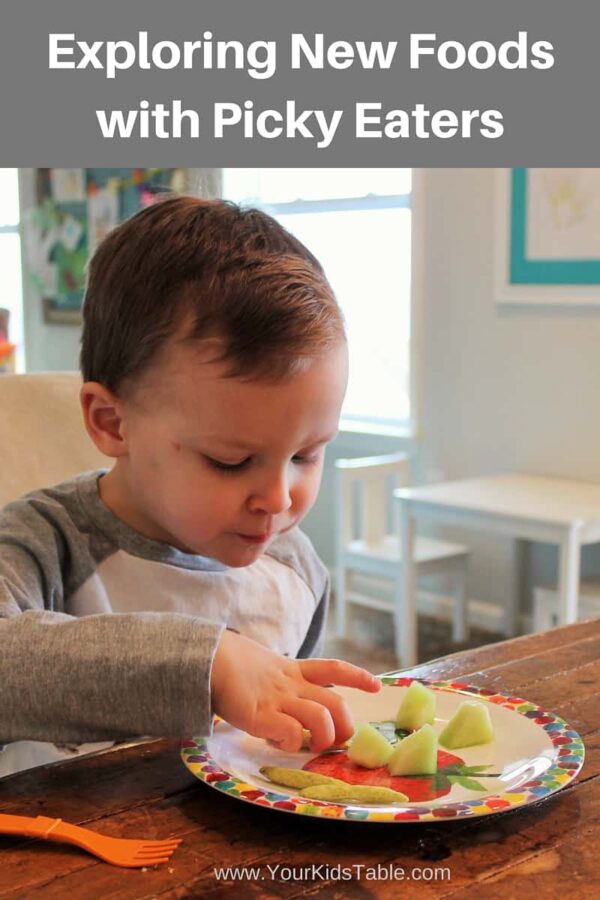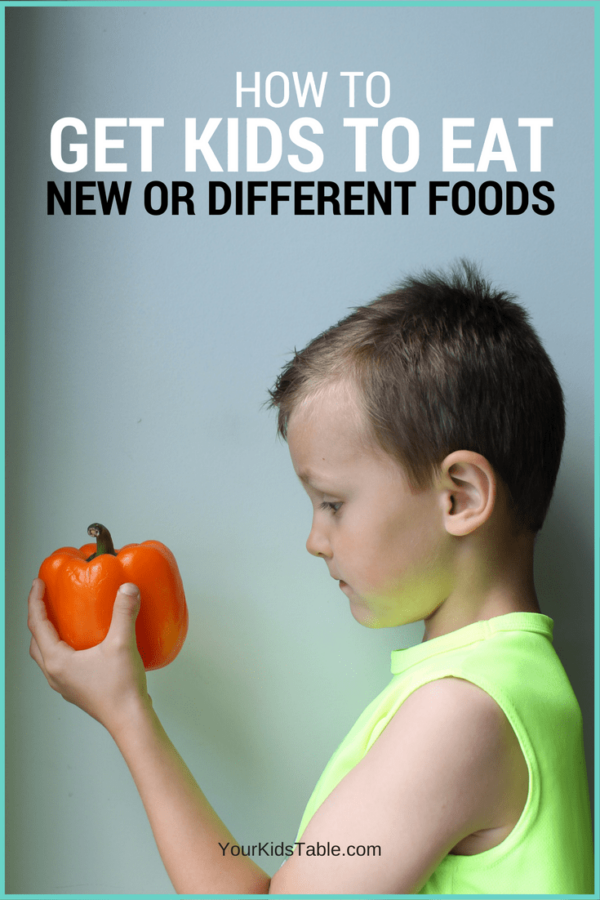We know that kids like consistency, routine, and things that are familiar. The unknown can be overwhelming and scary for them. It takes time for a new idea to seem comfortable enough for them to proceed. The same holds true for new foods. As adults, we take the myriad of foods we eat for granted. For some kids, a food that is a different color, texture, or shape is very foreign, unknown, and thus overwhelming. If it is overwhelming and scary, they probably aren’t going to eat it. (Find out why kids don’t eat)
How to Get Kids to Eat New Foods
Keeping that in mind, it makes perfect sense that they need to get more comfortable with it, right? In order for a kid to get more comfortable with foods they are refusing, they need to interact with it and feel no pressure to eat it. One of the best ways to achieve that is to play with food. Radical, I know, and it goes against good manners and the sort. But stay with me here, remember they need to get comfortable with food!
Generally, the first step is to get your child to look at or touch the food. Start there and be creative. You might say something like, “I have a forest growing on my plate” (stand up little pieces of broccoli). Or, if they already touched it, maybe you can get them to smell it, which will help them get it closer their face (that’s a big step for a “picky eater”). In this case, you could say, “Wow, my broccoli looks like a bouquet of flowers. I am going to smell my flowers. (You are waiting for them imitate)” From there you can move onto licking, tasting a small bite, and taking a normal bite. Also, give them permission to discreetly spit it out. I know, it’s gross and not very polite, but they may be more likely to try a bite if they know they can get rid of it if it tastes bad to them. I haven’t had any kid I work with get inappropriate with spitting it out. I don’t make a big deal about it and they move past it as they get more comfortable with the food.
Remember the key here is to have them be interested in what you are doing and imitate the action. It IS PROGRESS if they do something new with the food even if they don’t eat it! If they don’t follow your lead try something easier. You will want to follow this general progression, and not move onto something harder until they have demonstrated they can handle that: looking, touching, holding, moving food towards face, touching face with food, smelling, kissing, holding in teeth, taking small bites and spitting out, eating. It is very important that you don’t use these tasks as rewards or a checklist for them. This progression is something you use with play and exploration.
When Should You Try New or Refused Foods?
Here are three ways you can set up “play-time” with food:
1. Spend 2-3 minutes at the end of a meal “playing” with any refused foods. If your child has refused a food(s) at a meal, then before you clean up and move on, see if you can get them to interact with the food at all. I would avoid this if it is chaotic or your child has had enough of sitting for a meal. Aim for keeping this short and sweet.
2. Cook and prepare meals with your kids. Get your kid in the kitchen and help cook, without much help from you, they will be touching and smelling the food. You can still try some play as you are going, and I would gently encourage sampling of whatever is safe to eat while it is being prepared.
3. Set aside time (outside of a meal) to play with non-preferred foods. In between meals, set up some food exploration time at a table. It would be great if this was at a table they don’t normally eat at, so the association isn’t with eating. Have some utensils for cutting and getting creative. Most importantly, make sure you have set up food for yourself to play with, too. Ideally, they have a plate and you have a plate. You model and they imitate.
This Will NOT Get Kids to Eat…
I don’t want you to sabotage all your efforts, keep these “rules” in mind to make your hard work successful:
- Don’t force or try to shove food in, it is counterproductive and you may lose their trust.
- Just model for the child and encourage them to imitate whatever play you’re initiating. Don’t hold the food up for them to smell, let them do it. Hopefully, you will be following their lead. It is important they have control of the food they are interacting with.
- Keep it fun. If your kid gets upset or distracted, then try to end the play quickly and as positive as possible.
- Be patient. Don’t expect miracles after 10 minutes, an hour, or even a week. I have been there with my own kid and this may be the hardest part. It takes time, patience, and consistency. If you need some inspiration and strategies head to dealing with picky eaters.
- Keep the pressure off. The goal isn’t eating when you are exploring new foods, just play, and if they happen to eat it — bonus! Read more about this important picky eating tip here.
- These strategies aren’t just for new foods. I know quite well that picky eaters will often stop eating something they previously loved, never to touch it again. You can certainly employ these tactics for those lost foods, too.
I strongly believe in using play to explore new foods because it gives kids a chance to become more comfortable with foods they have no, little, or bad experiences with. However, it is often only one component of overcoming picky eating, especially for extreme picky eaters.
To learn more about what you can start doing today to help your child eat better, get a seat in my free workshop: 3 Keys to Turn Around Picky Eating! It could change everything, you won’t want to miss it. Sign up here.
More On Picky Eating
Expand On What Your Kid Is Already Eating
Sensory Processing and Picky Eating
Helping Your Child with Extreme Picky Eating {Book Review}
Managing Family Meals with a Picky Eater
Did You Pin This?


Any tips on a 2 year old who won’t eat any meat? Or vegetables?
Try these 2 articles:
How to Get Your Kid to Eat Meat
How to Get Your Child to Eat Vegetables Without a Battle or Tricking Them
Do you have any tips for my 2 year old that refuses oatmeal, porridges etc from a spoon and bowl but will have it in a sippy cup?
That’s really interesting! I’d start serving it both ways at the same time and offer every other day or even daily. Keep offering and trying. I’m wondering if there’s a sensory component going on.
Do you have any suggestions for a toddler who shoves a lot of food into their mouth at once? We can only give him 1 piece at a time. If we do 2, 3, etc., he’ll put everything on the tray in his mouth as fast as he can! Sometimes he’ll choke, and sometime he is able to chew/swallow is not issues.
I want to get him to try new things, but if that’s the only ‘bite’ on the tray he’ll pick it up, swing his hand to the side of the tray, and let it go to drop on the floor.
This can be common at this age, I’d try giving him a couple of pieces at a time and sitting right across from him with your full attention, if he tries to throw a piece, bring his arm back and say food stays on the tray. This will take a lot of practice and can get exhausting, but the consistency will pay off.